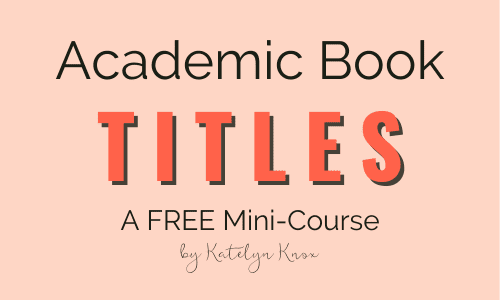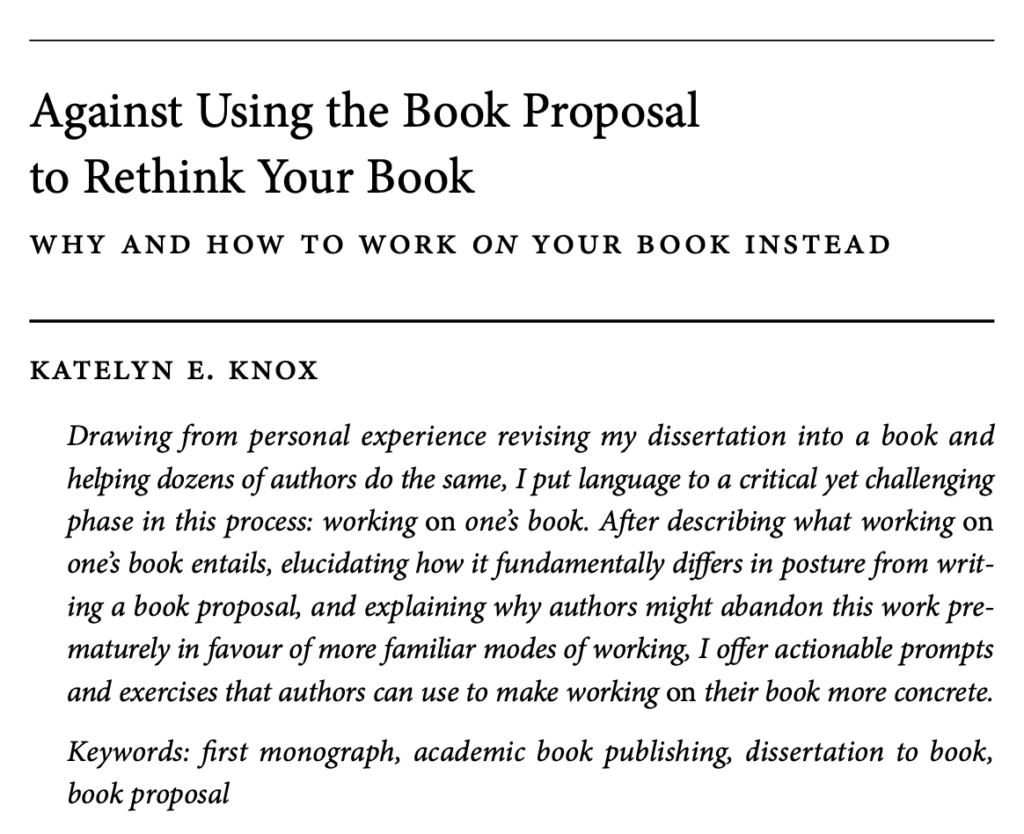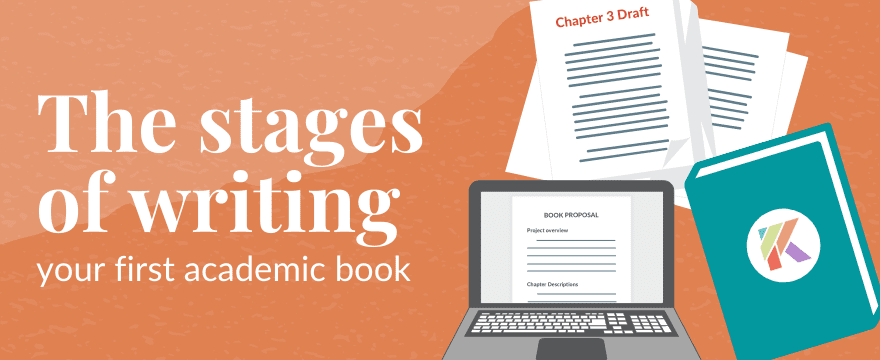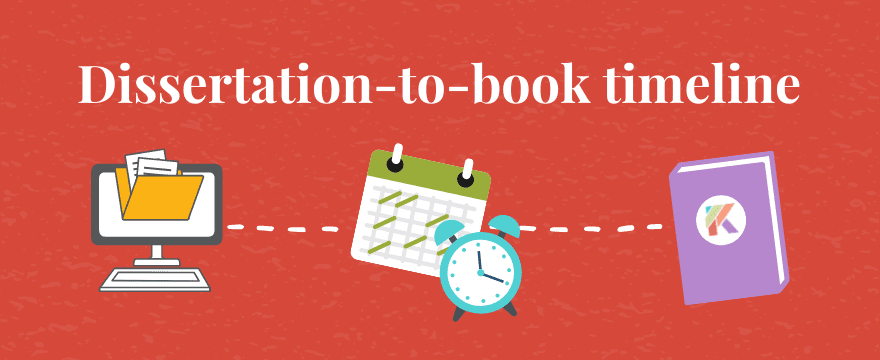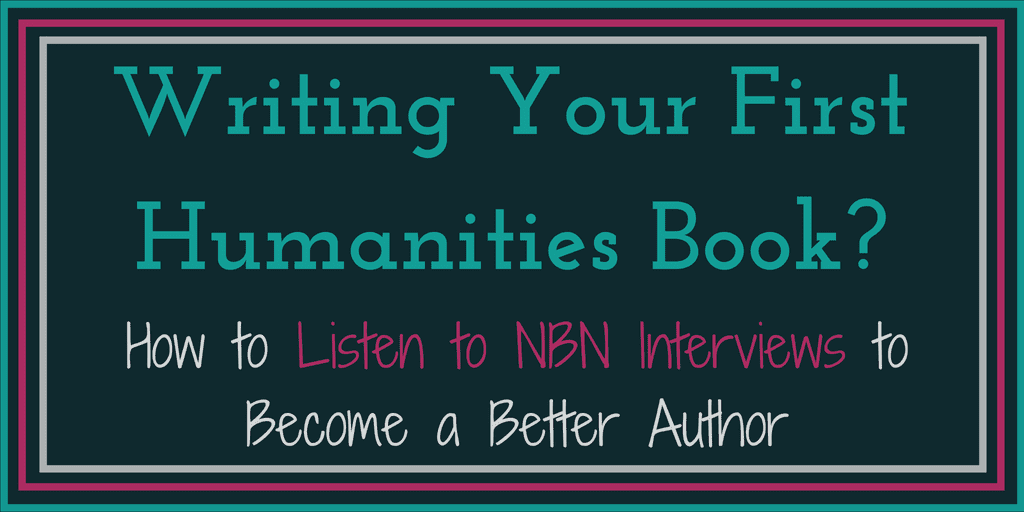The first time you publish an academic book, it feels like you need to master both a process you’ve hardly been trained to navigate and a style that’s quite different from your dissertation. In this post, I cut through the noise and direct you to the top resources that will help you understand the publishing process, produce a strong manuscript, develop solid productivity habits, and navigate the critical proposal stage.
Whether you’re just starting out and want to know how to avoid unnecessary frustration, or you’ve been revising for a while and are looking for resources to write more compellingly and efficiently, there’s something here for you!
Table of Contents
Feel Like the Whole Process is Opaque and Overwhelming? Start Here.
The Dissertation-to-Book Workbook
So, you’ve written a dissertation. Congratulations! But how do you turn it into a book? Even if you know what to do when revising your dissertation, do you know how to do those things? Our workbook, offers a series of manageable, concrete steps with exercises to help you revise your academic manuscript into publishable book form.
The Dissertation-to-Book Workbook uses targeted exercises and prompts to take the guesswork out of writing a book. You’ll clarify your book’s core priorities, pinpoint your organizing principle, polish your narrative arc, evaluate your evidence, and much more. Using what this workbook calls “book questions and chapter answers,” you’ll figure out how to thread your book’s main ideas through its chapters. Then, you’ll assemble an argument, and finally, you’ll draft any remaining material and revise the manuscript. And most important, by the time you complete the workbook, you’ll have confidence that your book works as a book—that it’s a cohesive, focused manuscript that tells the story you want to tell.
William Germano’s From Dissertation to Book, 2nd. ed
William Germano is the reference when it comes to revising your dissertation into a book. As a former editor-in-chief, he has years of experience mentoring junior scholars and reviewing book proposals. From Dissertation to Book helped me know what to expect of the process, how to make minor changes that majorly impacted my book (like his “Table of Contents” exercise), and how to begin to see my own project as editors would. It is also a must-have if you want concrete ways to assess whether to publish your dissertation as a book or as articles.
William Germano’s Getting it Published, 3rd. ed.
Getting it Published dives much deeper into the publishing process–helping you select a publisher, successfully draft proposals, and navigate the “nightmares” (as he puts it) you didn’t even know you would face, like image permissions. Like for From Dissertation to Book, the real value of Getting it Published is its perspective: as a former editor, Germano teaches you to see your book as editors will.
Publishing Your First Academic Monograph, Advice from Editors (Round Table Replay Video)
If you’re like me, you likely have tons of random questions about the book publishing process that only editors can answer. The problem? You can’t actually ask editors and risk tanking your book’s chances by projecting insecurity (at best), or bothering them (at worst). In this round table, acquisitions and series editors answer all your real questions, like “what are the most common proposal mistakes?,” “how long can my book be?,” and “how much of the manuscript can be pre-published?,” among many others.
Worried about Writing a Strong Book that Will Pass Peer Review?
First, Get some Quick Wins that Will Instantly Transform Your Manuscript
Revise Your Book’s Title with my Free Mini Course on Academic Book Titles
When my own acquisitions editor told me that my title was “terrible,” I thought I was the only one. Since then, countless authors have told me the same thing: “my editor told me my title needs to be search engine-friendly, but I don’t know how to do that.” To help them, I meticulously analyzed 188 humanities and social science book titles. The surprise? Very clear patterns emerged. Whether you’ve been told your title needs work or you want to produce a title that doesn’t send up red flags, this free course is for you.
Learn What “Book Voice” Sounds Like in Your Field
You’ve probably heard that dissertations and books have different “voices.” But much of the information on this topic remains extremely abstract. What does a “book voice” actually sound like? In this post, I show you, concretely, how to analyze published books in your field to get qualitative and quantitative benchmarks you can apply to your own book. As one author put it, it’s the most “helpful resource to quickly de-dissertationalize your book.”
Then, Revisit Your Project as a Whole
My article, “Against Using the Proposal to Rethink Your Book: Why and How to Work On Your Book Instead“
Have you been told to write a proposal to try to rethink your book project? In this article, I tell you why that’s not a good idea and show you what to do instead. Above all, you’ll find actionable activities and targeted prompts to do the highest-order work on your book like assessing and articulating your book-level claims, clarifying your book’s terms, pinpointing your book’s audience, and ensuring your book’s structure supports its overarching argument.
The New Books Network Podcast(s) in Your Field
While the New Books Network does not help you revise your project, per se, it can be an invaluable tool in helping you understand what academic book ideas and narrative arcs sound like. As you listen, note common interview questions and prepare yourself to answer them about your own book.
Finally, Craft Compelling Prose
Joseph M. Williams’s Style: Lessons in Clarity and Grace, 12th ed.
Using the principles from this book will revolutionize how you communicate complex and nuanced ideas in your scholarly writing. I refer to his lessons on “actions,” “characters,” “cohesion,” and “emphasis,” every time I revise a publication.
Eric Hayot’s The Elements of Academic Style
As one of my mentees put it, reading Hayot’s The Elements of Academic Style is like “seeing into the academic writing Matrix”–you leave forever changed. Specifically, Hayot’s model of the “Uneven U” (Chapter 8) was the resource that finally helped me write strong, argument-driven paragraphs. But there’s something for every book author here. Been told you cite too much? Wondering what to cite in the prose, what in the footnotes, and what to leave out? See Chapters 15, 19, and 23. Confused about how long your introduction and conclusion should be? See Chapters 11 and 17. Or, just want to refine your style? Part 3 (Chapters 19–31) was made for you.
Helen Sword’s Stylish Academic Writing
A must-have in an academic writer’s arsenal. Sword illustrates her points about stylish writing by drawing from real, published articles and chapters and explaining “why it works.” And each chapter concludes with a “Things to Try” section, which helps you practice developing your own style.
Struggling to Find the Time to Prioritize Your Book? Check these out.
Robert Boice’s Professors as Writers
It is not hyperbole to say that Boice’s Professors as Writers as the reason I was able to establish a strong publication pipeline. Based on years of quantitative and qualitative data working with real scholars, Boice’s book helps you diagnose your own writing obstacles (I identify personally with perfectionism and impatience) and develop actionable plans to write more regularly. Want to write three times as many pages and have twice as many creative ideas as your peers? Implement this book’s strategies asap.
Joli Jensen’s Write No Matter What
Do you regularly find yourself saying “I’ll just write as soon as I finish all my grading”? Worrying that your book will never be significant enough to be published? Finding yourself unable to finish chapters because you’re sure there’s a source you missed (and peer reviewers will automatically reject the whole book)? Unintentionally abandoning work on a project for two months because it started shifting beneath your feet and you couldn’t figure out how to get back to solid ground? Drop everything now and consult Parts 3 and 4 of Write No Matter What, where Jensen dispels common writing myths and helps you (re)establish and sustain momentum on your projects.

The Writing Habits that Make all the Difference for Me
Does this sound familiar? You face an imminent deadline and manage to finish your piece, but this last-minute push leaves you so burnt out that you take an extended break. You vow things will be different going forward, and you even manage to write regularly for a week or two. But then the grading piles up and you miss a few days. Disheartened, each week, you set more and more ambitious goals, which only increases your guilt when you fail to meet them. This post teaches you the concrete habits on which a regular writing practice depends. Pick one to cultivate in the coming weeks, and watch your guilt and shame begin to diminish.
Confused about How to Write a Winning Academic Book Proposal?
Laura Portwood-Stacer’s The Book Proposal Book
To say that academic book proposals are challenging is to put it mildly. Not only does each press have its own definition of what constitutes a proposal, but the proposal mode–writing about our arguments and claims for significance rather than making said arguments–is hardly something that we’re taught (or get to practice). Based on her work supporting hundreds of authors draft compelling proposals for university presses, Portwood-Stacer’s The Book Proposal Book is the go-to reference for academic book proposals.
Susan Rabiner and Alfred Fortunato, Thinking Like Your Editor
While written for authors of non-fiction books (and not those of academic monographs per se), Rabiner and Fortunato’s book helps you understand the questions all editors ask of the book proposals that cross their desks. In particular, their chapters on “Thinking like an Editor,” “How to Write a Proposal,” and “Using Narrative Tension” helped me understand what elements create a book’s “narrative arc” and how the various pieces of a book proposal should highlight it. If you only think of your academic book in argumentative–and not narrative–terms, this book is a must-read.
Rachel Toor, “The Reality of Writing a Good Book Proposal“
Academic authors have ample practice making argumentative claims in our books. But, as Rachel Toor, former acquisitions editor at at Oxford and Duke, illustrates in this essay, we often shut down when asked to make claims about our book. Consequently, we all too often default to dry information about our book, forgetting that, as Toor puts it, “a book proposal contains an invitation, a seduction, and an unromantic assessment of where you stand relative to others.” In this highly actionable article, Toor shows you exactly how to “make it easy for the editor to say yes.”
Rachel Toor, “How to Write a Good Book Proposal, The Sequel“
In this sequel post, Toor shows you how to tackle the “about the author,” “table of contents,” and “overview” sections of an academic book proposal and choose the sample chapter that will get editors’ attention. Not only will her perspective as a former acquisitions editor at Oxford and Duke help you understand what, exactly editors are looking for, but her targeted questions will help you craft the most compelling case for your book (and yourself) possible.




